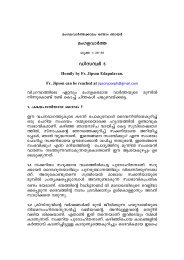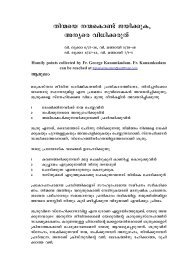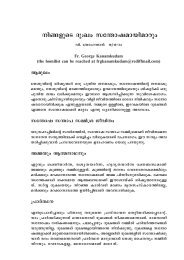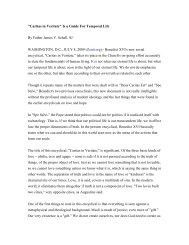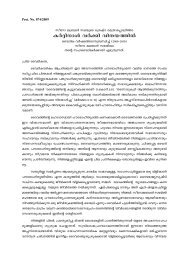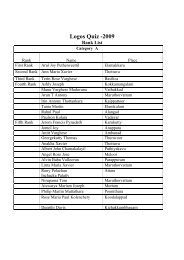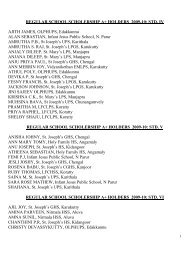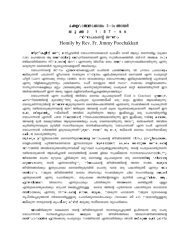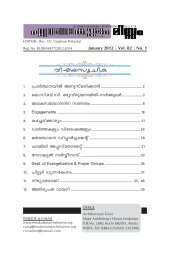THE TRINITARIAN COMMUNION - Archdiocese of Ernakulam ...
THE TRINITARIAN COMMUNION - Archdiocese of Ernakulam ...
THE TRINITARIAN COMMUNION - Archdiocese of Ernakulam ...
You also want an ePaper? Increase the reach of your titles
YUMPU automatically turns print PDFs into web optimized ePapers that Google loves.
and the presbyterate for pastoral care. The Revised Code <strong>of</strong> Canon Law invariably uses‘Particular Church’ to denote a diocese (cf.CCL.368-374).4. Raimundo Panikkar, The Trinity and the Religious Experience <strong>of</strong> Man: Icon-Person-Mystery(New York: Orbis Books, 1973), 42.5. J.M.R.Tillard, Flesh <strong>of</strong> the Church, Flesh <strong>of</strong> Christ, At the Source <strong>of</strong> Ecclesiology <strong>of</strong>Communion (Minnesota: The Liturgical Press, 1992), 1.6. John D.Zizioulas, Being as Communion (New York: St.Vladimir’s Seminary Press, 1985), 17.7. J.M.R.Tillard, Flesh <strong>of</strong> the Church, Flesh <strong>of</strong> Christ, At the Source <strong>of</strong> Ecclesiology <strong>of</strong>Communion, 1-12.8. Jacob Parappally, “Communion Among Individual Churches: A Theological Reflection”Vidyajyoti Vol. 59, No.11 (November 1995), 755.9. John D. Zizioulas, Being as Communion (New York: St.Vladimir’s Seminary Press 1985), 17.10. Jacob Parappally, “Communion Among The Individual Churches: A Theological Reflection”,753.11. Ernest Skublics, “Communion Ecclesiology: The Church As Sacramentum Mundi,” in One inChrist Vol. 34, No. 2, (1988), 129.12. Ernest Skublics, “Communion Ecclesiology: The Church As Sacramentum Mundi,” 129-130.13. Ibid., also cf. R.Gilsdorf, “Koinonia: Communion or Fellowship.” Gilsdorf writes about thedivine communion as follows; “The relational acts…constitute the essence <strong>of</strong> this divinecommunion, which thereby constitutes a community <strong>of</strong> three persons: this is the Trinity, acommunity <strong>of</strong> three co-equal, co-eternal Persons, possessing one undivided, limitless life, oneEssence, one Existence, related together in the bonds <strong>of</strong> infinite Truth and Love.” pp. 25-32.14. Susan K.Wood, “The Church as Communion,” The Gift <strong>of</strong> the Church: A Textbook onEcclesiology, ed., Peter C.Phan (Minnesota: The Liturgical Press, 2000), 160.15. B.C.Butler, The Church and Unity (London: Ge<strong>of</strong>frey Chapman, 1979) 38.16. Ibid., 36-37.17. Thomas Marsh, The Triune God: A Biblical, Historical, and Theological Study (Connecticut:Twenty-Third Publications, 1994), 9.18. Walter Kasper, The God <strong>of</strong> Jesus Christ (London: SCM Press, 1984), 223.19. Catherine Mowry LaCugna, God For Us. The Trinity and Christian Life (New York: HarperCollins Publishers, 1991), 1.20. George H.Tavard, The Vision <strong>of</strong> the Trinity (Washington: University Press <strong>of</strong> America, 1981),93.21. Catherine Mowry LaCugna, God For Us: The Trinity and Christian Life, 1.22. Ernest Skublics, “Communion Ecclesiology: The Church As Sacramentum Mundi,” 129.23. Ibid., 128.24. Ibid., 129. He writes, “Baptism constitutes the individual as person and member <strong>of</strong> the Body,the communion. Chrismation/confirmation fills out a number <strong>of</strong> meanings in thisincorporation, and the Eucharist completes it. Penance/reconciliation restores that communion<strong>of</strong> it should be lost or broken, and the anointing <strong>of</strong> the sick brings healing (whole-making) toit. Holy orders <strong>of</strong> course assign a place and function to a person in and for the sake <strong>of</strong> theBody, while matrimony images and sacramentalizes the very reality <strong>of</strong> the Church for aspecific couple and family. Each and every sacrament is a particular moment <strong>of</strong> bestowing,restoring or enhancing communion, and thereby being, life and salvation.”25. Leonardo B<strong>of</strong>f, Trinity and Society, Trans. Paul Burns, (New York: Orbis Books, 1986), 25-26.26. J.P.Arendzen, The Holy Trinity: A Theological Treatise for Modern Layman (London: Seed &Ward, 1937), 38.27. J.P. Arendzen, The Holy Trinity: A Theological Treatise for Modern Layman (London: Seed& Ward, 1937), 33.28. “In other words the name represented the person. To know the name meant to know theperson, to know his very essence…Thus the name was not only a picture <strong>of</strong> the (hu)man whoowned it; it was in sense a representation <strong>of</strong> that (hu)man, a reflexion <strong>of</strong> him/her, his/her alterego, separable from him/her, yet <strong>of</strong> meaningless without the (hu)man to whom the namebelonged (Deut 7:24, 9:14; Ps 109:13; Prov 10:7; Is 56:5).” G.A.F. Knight, A BiblicalApproach to the Doctrine <strong>of</strong> the Trinity (London: Oliver and Boyd, 1957), 12.29. “In the Old Testament scriptures, God is known through many names, above all through thepersonal name <strong>of</strong> YHWH (e.g.,Ex 3:14; 6:6-8), the most sacred <strong>of</strong> names that is used about6800 times in the Old Testament, both by itself or in compounds like YHWH Malak (“King”:e.g., Ps 93:1). God is also generically known as El (“divinity”), as in El Shaddai (“God, the



